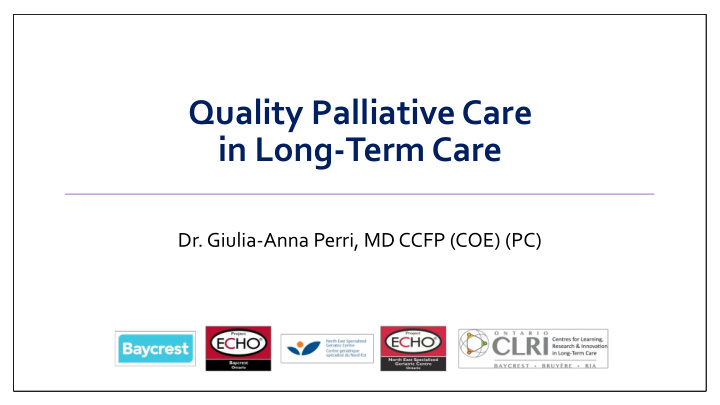



Quality Palliative Care in Long-Term Care Dr. Giulia-Anna Perri, MD CCFP (COE) (PC)
Faculty/Presenter Disclosure Faculty: Dr. Giulia-Anna Perri • Relationships with financial sponsors: • No relationships
Disclosure of Financial Support • This program has NOT received financial support other than the support of the MOHLTC • This program has NOT received in-kind support • Potential for conflict(s) of interest: None to be disclosed
Mitigating Potential Bias The information presented in this CME program is based on recent information that is explicitly ‘‘evidence - based’’. This CME Program and its material is peer reviewed and all the recommendations involving clinical medicine are based on evidence that is accepted within the profession; and all scientific research referred to, reported, or used in the CME/CPD activity in support or justification of patient care recommendations conforms to the generally accepted standards
Objectives 1) Differentiate between palliative and end- of-life care. 2) Recognize quality indicators for the palliative approach to care in LTCHs. 3) Describe a palliative approach to symptom control.
How would you define palliative care? And how would you differentiate it from end of life care?
Palliative and End of Life Care Palliative care is an approach that improves the quality of life of patients and their families facing the problems associated with life-threatening illness , through the prevention and relief of suffering by means of early identification and impeccable assessment and treatment of pain and other problems, physical, psychosocial and spiritual. End of Life: Prognosis is short (< 3 months) Actively Dying: Prognosis is very short (hours to days) WHO, 2012
Old Concept Curative Care Palliative Care Diagnosis Death Illness trajectory
The Palliative Approach to Care Aims To: 1 Enhance quality of life and provide pain and symptom relief 2 Affirm life & regards dying as part of the normal process of living 30% of Canadians have access to 3 Neither hasten nor prolong death palliative care and end of life 4 Integrates psychological & spiritual aspects of care services. 5 Offers a support system to help individuals live & reach their goals until death 6 Offer a support system to help the family cope during the patient’s illness and throughout their own bereavement Individuals with Advanced Dementia receive 7 Offers involvement early in the course of illness, in conjunction suboptimal palliative care. with other therapies that are intended to prolong life, and includes investigations to better understand and manage distressing clinical complications
WHAT ARE THE COMPONENTS OF QUALITY PALLIATIVE CARE?
Word Cloud Menti.com 940631
HQO: Palliative Care QUALITY STATEMENT 1: Identification and Assessment of Needs
How do you identify residents who may benefit from the palliative approach to care?
Indicators that EOL is approaching General indicators of decline Disease specific indicators Surprise Question; “Would I be surprised if my Resident died in the next year?” https://www.goldstandardsframework.org.uk
General Indicators of Decline General physical decline, increasing dependence and needs for support Repeated unplanned hospital admissions Advanced disease Multiple, significant co -morbidities Decreasing activity Decreasing response to treatments, decreasing reversibility Resident choice for not further active treatment and focus on QOL Progressive weight loss (>10% in 6 months) Sentinel event Serum albumin (<25g /L) https://www.goldstandardsframework.org.uk
Unable to walk without assistance and Bladder and bowel incontinence, and Disease specific No consistently meaningful conversation and indicators for Unable to do ADLs (Barthel sore < 3) dementia: Plus any of the following: Weight loss UTI Severe pressure sores – stage 3 or 4 Recurrent fever Reduced oral intake Aspiration pneumonia https://www.goldstandardsframework.org.uk
The Surprise Question For residents with advanced disease or progressive life limiting conditions, would you be surprised if the resident were to die in the next year, months, weeks, days? https://www.goldstandardsframework.org.uk
HQO: Palliative Care QUALITY STATEMENT 2: Timely Access to Palliative Care Support
HQO: Palliative Care QUALITY STATEMENT 3: Advance Care Planning – Substitute Decision-Maker
HQO: Palliative Care QUALITY STATEMENT 4: Goals of Care Discussion and Consent
HQO: Palliative Care QUALITY STATEMENT 5: Individualized, Person-Centered Care Plan
HQO: Palliative Care QUALITY STATEMENT 6: Management of Pain and Other Symptoms
The Palliative Approach to Symptom Management Goals of Burden of ESAS Function PPS Symptoms Care Management Framework Investigate/Treat the Non- Pharmacological Underlying and/or Pharmacological Options Contributing Cause? Approaches Client-Centered Education
The “End -of- Life” Kit Written Information Medications: - Stop all medications that aren’t contributing to comfort - Convert all oral symptom control medications to sc route - Ensure access to different classes of symptom control sc medications: Opioids, Antipsychotics, Benzodiazapines, Anti-cholinergics. - Suppositories Supplies: - SC lines Pronouncement & Bereavement Debrief as a - Catheters Death Certificate protocols Program team/community - Mouth care
HQO: Palliative Care QUALITY STATEMENT 7: Psychosocial Aspects of Care
HQO: Palliative Care QUALITY STATEMENT 8: Education for Patients, SDMs, Families, and Caregivers
HQO: Palliative Care QUALITY STATEMENT 9: Caregiver support
HQO: Palliative Care QUALITY STATEMENT 10: Transitions in Care
HQO: Palliative Care QUALITY STATEMENT 11: Setting of Care and Place of Death
HQO: Palliative Care QUALITY STATEMENT 12: Interdisciplinary Team-Based Care
HQO: Palliative Care QUALITY STATEMENT 13: Education for Health Care Providers and Volunteers
• Gold Standard Framework: http://www.goldstandardsframework.org.uk/ • HQO Palliative Care Quality Indicators: https://www.hqontario.ca/portals/0/documents/evidence/quality- standards/qs-palliative-care-clinical-guide-en.pdf • Ontario Palliative Care Network: https://www.ontariopalliativecarenetwork.ca/en • Canadian Virtual Hospice: http://www.virtualhospice.ca Resources • ESAS: https://www.cancercareontario.ca/sites/ccocancercare/files/assets/C COESAS-English.pdf?redirect=true • PPS: https://www.victoriahospice.org/sites/default/files/ppsv2_qa_instruc tions_definitionsoct2018update.pdf • Pallium Canada: https://pallium.ca/ • Hospice Palliative Care Ontario (HPCO): https://www.hpco.ca/ • Speak Up: http://www.advancecareplanning.ca/
gperri@baycrest.org
Recommend
More recommend